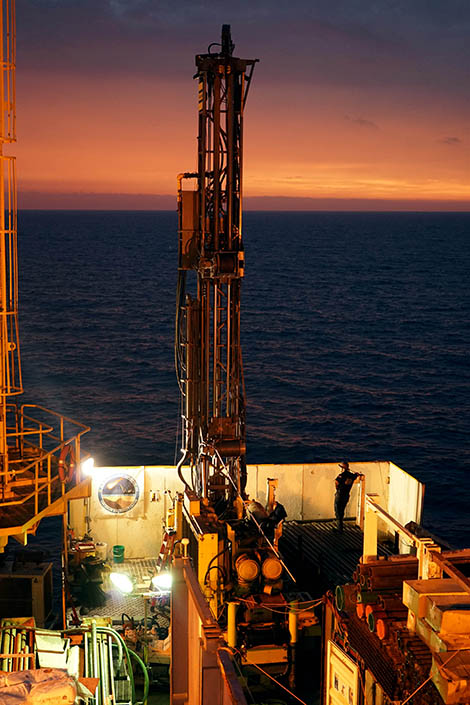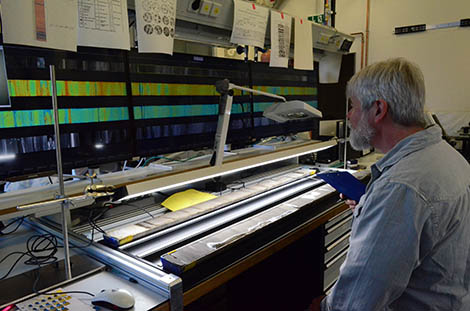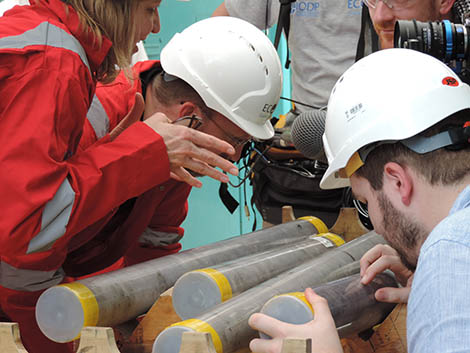
Chicxulub: a unique crater to elucidate planetary surfaces
The fall of an asteroid in the Yucatán Peninsula (Mexico) 66 million years ago is believed to have caused the extinction of dinosaurs. It also created the Chicxulub impact crater, the only such crater on Earth that still has a peak ring – a type of structure commonly found, in contrast, on the surface of several objects in the Solar System. As a result, and despite the crater being buried under several hundred meters of sediment, scientists the world over will do anything to uncover its secrets. The IODP/ICDP Expedition 364, carried out by an international team1 of researchers from the CNRS, Aix-Marseille Université and the Université de Bourgogne, has published its initial findings in the 18 November 2016 edition of Science: for the first time, 835 metres of collected core samples will reveal how rock formations occurred while this type of crater developed.
- 1“Expedition 364” was carried out as part of the International Ocean Discovery Program (IODP), which receives significant support from the CNRS; the International Continental Scientific Drilling Program (ICDP), and coordinated by the European Consortium for Ocean Research Drilling (ECORD). The project brought together 60 scientists, engineers and support staff, in particular from the British Geological Survey, the European Petrophysics Consortium (EPC) (University of Leicester, Université de Montpellier and RWTH Aachen University), and MARUM (Universität Bremen).
IODP/ICDP Expedition 364 began with two months of offshore drilling between April and May 2016 on board the L/B Myrtle. Shallow water drilling during this first phase of the mission allowed scientists to collect 303 core samples (sediments and impactites2
) of excellent quality, and nearly 6 km of accumulated well data. This data was analyzed by an international team of around 30 scientists, four of whom work for French laboratories: the first to unearth the rocks that form the peak ring of an impact crater.
This is the first time the peak ring of a meteorite crater has been drilled. A peak ring is a circular structure of often irregular hills located inside a large crater. Frequently observed on the surfaces of silicated bodies in the Solar System, including the Moon, Mercury and Venus, these topographical structures are the subject of considerable debate as to how they formed, and, until now, had never been sampled.
Researchers observed that the peak ring is predominantly made up of granitic rock (combined with molten rock) which, in addition to being shocked, was shifted several kilometres towards the surface during impact. These rocks are also cross-cut by shear zones. Analysis shows that impact generated vertical fluxes and increased porosity in planetary crust. The type of rocks that form the peak ring on the Chicxulub crater and their physical characteristics confirm the 'dynamic collapse' model of peak-ring formation. These results are the first in a long series that will partially lift the veil on this type of crater, from the role it plays in the geology of the planets to its impact on climate. Researchers also hope to determine whether ancient or more recent types of microbial life were able to grow in the rocks of the peak ring.
The IODP/ICDP team is composed of 60 scientists, engineers and support staff, including several French researchers working in France and abroad:
- Elise Chenot (sedimentology) from the Biogéosciences laboratory of the CNRS/Université de Bourgogne,
- Ludovic Ferrière (mineralogy and shock effects) from the Vienna Museum of Natural History in Austria,
- Erwan Le Ber (petrophysics) from the University of Leicester (UK) and a member of the European Petrophysics Consortium,
- Johanna Lofi (down-hole geophysics and petrophysics) from the Géosciences Montpellier laboratory (CNRS/Université de Montpellier/ Université des Antilles) and a member of the European Petrophysics Consortium,
- Rubén Ocampo-Torres (organic geochemistry) from the Institute of Chemistry and Processes for Energy, Environment and Health (ICPEES) (CNRS/Université de Strasbourg),
- William Zylberman (geophysics and paleomagnetism of impact craters) from the Centre européen de recherche et d'enseignement de géosciences de l'environnement (CEREGE) (CNRS/AMU/IRD/Collège de France) and the Centre for Planetary Science and Exploration at the University of Western Ontario (Canada).
Down hole geophysical data was collected for the EPC by CNRS engineers: Laurent Brun, Gilles Henry, Jehanne Paris.

The L/B Myrtle drilling platform.

The L/B Myrtle drilling platform.

Petrographic study of the core samples at the marine research centre in Marum (Bremen, Germany).

Core samples collected during the expedition.
- 2Impactites are rocks which are newly formed or have been modified by a meteoritic impact. These unique rocks contain shocked minerals and/or melts, formed by the high pressure and temperatures generated by the impact.
The formation of peak rings in large impact craters. Joanna Morgan, Sean Gulick, Timothy Bralower, Elise Chenot, Gail Christeson, Philippe Claeys, Charles Cockell, Gareth S. Collins, Marco J. L. Coolen, Ludovic Ferrière, Catalina Gebhardt, Kazuhisa Goto, Heather Jones, David A. Kring, Erwan Le Ber, Johanna Lofi, Xiao Long, Christopher Lowery, Claire Mellett, Rubén Ocampo-Torres, Gordon R. Osinski, Ligia Perez-Cruz, Annemarie Pickersgill, Michael Pölchau, Auriol Rae, Cornelia Rasmussen, Mario Rebolledo-Vieyra, Ulrich Riller, Honami Sato, Douglas R. Schmitt, Jan Smit, Sonia Tikoo, Naotaka Tomioka, Jaime Urrutia-Fucugauchi, Michael Whalen, Axel Wittmann, Kosei Yamaguchi, William Zylberman. Science, 18 November 2016. 10.1126/science.aah6561
View web site


